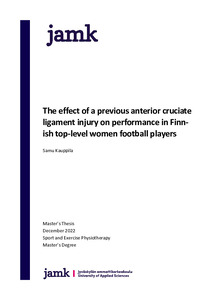The effect of a previous anterior cruciate ligament injury on performance in Finnish top-level women football players
Kauppila, Samu (2023)
Kauppila, Samu
2023
All rights reserved. This publication is copyrighted. You may download, display and print it for Your own personal use. Commercial use is prohibited.
Julkaisun pysyvä osoite on
https://urn.fi/URN:NBN:fi:amk-202302202596
https://urn.fi/URN:NBN:fi:amk-202302202596
Tiivistelmä
Anterior cruciate ligament injuries make a major burden in women’s football. Besides requiring a time-consuming rehabilitation period, the rehabilitation of these injuries often leave functional deficiencies to players for further years and are easily recurring. ACL injuries count for a major time loss for all injuries in women’s football, but they might also force the women players end their career earlier, not return to play either in the same level, or at all.
The further performance after returning to football has not been widely studied in women’s football, and there has been a question whether the history of an ACL injury would impact e.g., on the playing minutes after returning to play in top-level. The aim of the study was to gain further knowledge of performance and further injuries in ACL-rehabilitated players in relation to players without an ACL injury history. The purpose is to clarify the integrity of women’s ACL injuries, rehabilitation conventions and the return to play to the top-level football demands. With the data of the UKK Institute and FA Finland, the injury incidence vs. playing minutes was studied. The data of the study were analyzed using statistical analysis methods of SPSS.
The study recognized that the players with an ACL injury history played significantly fever playing minutes in the Finnish National League season 2020 in relation to the players without ACL injury history. There was similarity in the incidence of further injuries in both groups, and in the study the playing minutes in the season weren’t related to the incidence of injuries during the same season.
In conclusion, it was suggested that in the rehabilitation of women players to the top-level demands there needs to be a good understanding of the player & rapidly evolved demands of the top-level football in the multidisciplinary medical team that leads the rehabilitation and training of the injured player. In the future, more clear guidelines for rehabilitation of an ACL injured women player in the different stages could be in use for the sports physiotherapy practitioners.
The further performance after returning to football has not been widely studied in women’s football, and there has been a question whether the history of an ACL injury would impact e.g., on the playing minutes after returning to play in top-level. The aim of the study was to gain further knowledge of performance and further injuries in ACL-rehabilitated players in relation to players without an ACL injury history. The purpose is to clarify the integrity of women’s ACL injuries, rehabilitation conventions and the return to play to the top-level football demands. With the data of the UKK Institute and FA Finland, the injury incidence vs. playing minutes was studied. The data of the study were analyzed using statistical analysis methods of SPSS.
The study recognized that the players with an ACL injury history played significantly fever playing minutes in the Finnish National League season 2020 in relation to the players without ACL injury history. There was similarity in the incidence of further injuries in both groups, and in the study the playing minutes in the season weren’t related to the incidence of injuries during the same season.
In conclusion, it was suggested that in the rehabilitation of women players to the top-level demands there needs to be a good understanding of the player & rapidly evolved demands of the top-level football in the multidisciplinary medical team that leads the rehabilitation and training of the injured player. In the future, more clear guidelines for rehabilitation of an ACL injured women player in the different stages could be in use for the sports physiotherapy practitioners.
